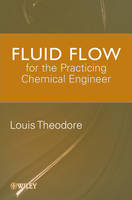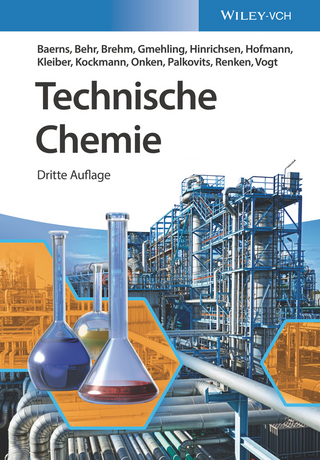
Fluid Flow for the Practicing Chemical Engineer
Wiley-AIChE (Verlag)
978-0-470-31763-1 (ISBN)
- Titel z.Zt. nicht lieferbar
- Versandkostenfrei innerhalb Deutschlands
- Auch auf Rechnung
- Verfügbarkeit in der Filiale vor Ort prüfen
- Artikel merken
James P. Abulencia is an Assistant Professor at Manhattan College. He received his BS degree in chemical engineering from Manhattan College, and his PhD in chemical and biomolecular engineering from Johns Hopkins University. In addition to teaching fluid flow, his research interests include the role of shear stress in blood thrombus formation, the gene regulation of chondrocytes, and tissue engineering strategies of osteochondral tissue. Louis Theodore, PHD, is a Professor in the Chemical Engineering Department of Manhattan College. Dr. Theodore is coauthor of Introduction to Hazardous Waste Incineration, Second Edition; Handbook of Chemical and Environmental Engineering Calculations; author of Nanotechnology: Basic Calculations for Engineers and Scientists; and a contributor to Perry's Chemical Engineers' Handbook.
Preface. Introduction.
I. Introduction to Fluid Flow.
1. History of Chemical Engineering—Fluid Flow.
1.1 Introduction.
1.2 Fluid Flow.
1.3 Chemical Engineering.
References.
2. Units and Dimensional Analysis.
2.1 Introduction.
2.2 Dimensional Analysis.
2.3 Buckingham Pi (π) Theorem.
2.4 Scale-Up and Similarity.
References.
3. Key Terms and Definitions.
3.1 Introduction.
3.2 Definitions.
References.
4. Transport Phenomena Versus Unit Operations.
4.1 Introduction.
4.2 The Differences.
4.3 What is Engineering?
References.
5. Newtonian Fluids.
5.1 Introduction.
5.2 Newton’s Law of Viscosity.
5.3 Viscosity Measurements.
5.4 Microscopic Approach.
References.
6. Non-Newtonian Flow.
6.1 Introduction.
6.2 Classification of Non-Newtonian Fluids.
6.3 Microscopic Approach.
References.
II. Basic Laws.
7. Conservation Law for Mass.
7.1 Introduction.
7.2 Conversation of Mass.
7.3 Microscopic Approach.
References.
8. Conservation Law for Energy.
8.1 Introduction.
8.2 Conservation of Energy.
8.3 Total Energy Balance Equation.
References.
9. Conservation Law for Momentum.
9.1 Momentum Balances.
9.2 Microscopic Approach: Equation of Momentum Transfer.
References.
10. Law of Hydrostatics.
10.1 Introduction.
10.2 Pressure Principles.
10.3 Manometry Principles.
Reference.
11. Ideal Gas Law.
11.1 Introduction.
11.2 Boyle’s and Charles’ Laws.
11.3 The Ideal Gas Law.
11.4 Non-Ideal Gas Behavior.
References.
III. Fluid Flow Classification.
12. Flow Mechanisms.
12. 1 Introduction.
12.2 The Reynolds Number.
12.3 Strain Rate, Shear Rare, and Velocity Profile.
12.4 Velocity Profile and Average Velocity.
Reference.
13. Laminar Flow in Pipes.
13.1 Introduction.
13.2 Friction Losses.
13.3 Tube Size.
13.4 Other Considerations.
13.5 Microscopic Approach.
References.
14. Turbulent Flow in Pipes.
14.1 Introduction.
14.2 Describing Equations.
14.3 Relative Roughness in Pipes.
14.4 Friction Factor Equations.
14.5 Other Cosiderations.
14.6 Flow Through Several Pipes.
14.7 General Predictive and Design Approaches.
14.8 Microscopic Approach.
References.
15. Compressible and Sonic Flow.
15.1 Introduction.
15.2 Compressible Flow.
15.3 Sonic Flow.
15.4 Pressure Drop Equations.
References.
16. Two-Phase Flow.
16.1 Introduction.
16.2. Gas (G)-Liquid (L) Flow Principles: Generalized Approach.
16.3 Gas (Turbulent) Flow—Liquid (Turbulent) Flow.
16.4 Gas (Turbulent) Flow-Liquid (Viscous) Flow.
16.5 Gas (Viscous) Flow-Liquid (Viscous) Flow.
16.6 Gas – Solid Flow.
References.
IV. Fluid Flow Transport and Applications.
17. Prime Movers.
17.1 Introduction.
17.2 Fans.
17.3 Pumps.
17.4 Compressors.
References.
18. Valves and Fittings.
18.1 Valves.
18.2 Fittings.
18.3 Expansion and Contraction Effects.
18.4 Calculating Losses of Valves and Fittings.
18.5 Fluid Flow Experiment: Data and Calculations.
References.
19. Flow Measurement.
19.1 Introduction.
19.2 Manometry and Pressure Measurements.
19.3 Pitot Tube.
19.4 Venturi Meter.
19.5 Orifice Meter.
19.6 Selection Process.
Reference.
20. Ventilation.
20.1 Introduction.
20.2 Indoor Air Quality.
20.3 Indoor Air/Ambient Air Comparison.
20.4 Industrial Ventilation Systems.
References.
21. Academic Applications.
References.
22. Industrial Applications.
References.
V. Fluid-Particle Applications.
23. Particle Dynamics.
23.1 Introduction.
23.2 Particle Classification and Measurement.
23.3 Drag Force.
23.4 Particle Force Balance.
23.5 Cunningham Correction.
23.6 Liquid-Particle Systems.
23.7 Drag on a Flat Plate.
References.
24. Sedimentation, Centrifugation, Flotation.
24.1 Sedimentation.
24.2 Centrifugation.
24.3 Hydrostatic Equilibrium in Centrifugation.
24.4 Flotation.
References.
25. Porous Media and Packed Beds.
25.1 Introduction.
25.2 Definitions.
25.3 Flow Regimes.
References.
26. Fluidization.
26.1 Introduction.
26.2 Fixed Beds.
26.3 Permeability.
26.4 Minimum Fluidization Velocity.
26.5 Bed Height, Pressure Drop and Porosity.
26.6 Fluidization Modes.
26.7 Fluidization Experiment Data and Calculations.
References.
27. Filtration.
27.1 Introduction.
27.2 Filtration Equipment.
27.3 Describing Equations.
27.4 Filtration Experimental Data and Calculations.
References.
VI. Special Topics.
28. Environmental Management.
28.1 Introduction.
28.2 Environmental Management History.
28.3 Environmental Management Topics.
28.4 Applications.
References.
29. Accident and Emergency Management.
29.1 Introduction.
29.2 Legislation.
29.3 Health Risk Assessment.
29.4 Hazard Risk Assessment.
29.5 Illustrative Examples.
References.
30. Ethics.
30.1 Introduction.
30.2 Teaching Ethics.
30.3 Case Study Approach.
30.4 Integrity.
30.5 Moral Issues.
30.6 Guardianship.
30.7 Engineering and Environmental Ethics.
30.8 Applications.
References.
31. Numerical Methods.
31.1 Introduction.
31.2 Early History.
31.3 Simultaneous Linear Algebraic Equations.
31.4 Nonlinear Algebraic Equations.
31.5 Numerical Integration.
References.
32. Economics and Finance.
32.1 Introduction.
32.2 The Need for Economic Analyses.
32.3 Definitions.
32.4 Principles of Accounting.
32.5 Applications.
References.
33. Biomedical Engineering.
33.1 Introduction.
33.2 Definitions.
33.3 Blood.
33.4 Blood Vessels.
33.5 Heart.
34.6 Plasma/Cell Flow.
34.7 Biomedical Engineering Opportunities.
References.
34. Open-Ended Problems.
34.1 Introduction.
34.2 Developing Students’ Power of Critical Thinking.
34.3 Creativity.
34.4 Brainstorming.
34.5 Inquiring Minds.
34.6 Angels on a Pin.
34.7 Applications.
References.
Appendix.
Index.
| Reihe/Serie | Essential Engineering Calculations Series |
|---|---|
| Sprache | englisch |
| Maße | 160 x 234 mm |
| Gewicht | 930 g |
| Themenwelt | Naturwissenschaften ► Chemie ► Technische Chemie |
| Naturwissenschaften ► Physik / Astronomie ► Strömungsmechanik | |
| Technik | |
| ISBN-10 | 0-470-31763-9 / 0470317639 |
| ISBN-13 | 978-0-470-31763-1 / 9780470317631 |
| Zustand | Neuware |
| Informationen gemäß Produktsicherheitsverordnung (GPSR) | |
| Haben Sie eine Frage zum Produkt? |
aus dem Bereich


